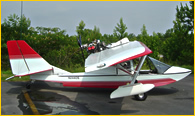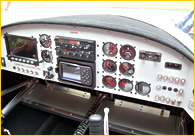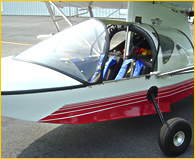The SeaRey
About the SeaRey
The SeaRey has generated a great deal of enthusiasm for water flying since its first flight in November of 1992. It has proven itself over thousands of hours to be well designed, reliable and durable, while providing superior flight characteristics.
The SeaRey is a sport pilot eligible kit-built aircraft incorporating state-of-the-art light aircraft technology. The kit includes all parts necessary to build your own aircraft. You’ll need to supply only the finish color paint.
A strong pilot community has grown up around the SeaRey, ranging from the Pacific Northwest to Florida and into Canada. Building and flying a SeaRey can be an individual exploration, or an invitation to join up with others for expeditions to some of the most interesting water destinations in North America.
The SeaRey kit is manufactured by Progressive Aerodyne, Inc., in Orlando, Florida.
Features of the SeaRey
The SeaRey's sleek, streamlined appearance is impressive. It is a high wing, pusher configuration, tail dragger. The wings are swept back at the leading edge with a straight trailing edge to form a tapered wing. The engine is mounted on top of the wing. Features include:
- Side by side seating
- Efficient tapered wings
- Fiberglass wing tips
- Composite hull and decks
- Sliding canopies, both sides
- Stits covered wings & tail
- 18 gallon fuel tank (28 gal optional)
- Streamlined struts
- 3 position mechanical flaps
- Mechanical brakes (optional hydraulic brakes)
- Dual controls
- Electric stabilizer trim
- 6" pneumatic wheels, aluminum hubs
Standard Components & Materials
Fiberglass hull, nose deck, turtle deck and wing tips: The SeaRey's hull, nose deck, and turtle deck are composed of strong, lightweight, reinforced fiberglass. The pieces are riveted together. The nose deck has molded into it an instrument panel and an access hatch on top measuring about 9 inches by 10 inches. Fiberglass components are white gel-coated and need not be painted. However, they can be custom painted to suit personal taste. Fiberglass wing tips have drooped tips which extend back to the trailing edge of the ailerons. There is a raised section especially for installing optional navigation and strobe lights.
Sliding canopies and windshield: The windshield and sliding canopies are made of optically clear polycarbonate material. The canopies slide easily on tracks mounted on each side of the cabin. Locks are provided.
Fuel tank: The standard 18 gallon (U.S.) Fuel Tank is made of durable rotocast plastic. It mounts below the storage area aft of the seats. (Optional extended range fuel tank available.)
Streamlined wing struts and float struts: The standard wing struts and float struts are made of streamlined, aircraft-grade aluminum for improved flight performance and appearance.
Wing floats:
The standard wing floats are constructed of durable, lightweight rotocast plastic. The color is white.
Flying surfaces:
Wings and all flying surfaces are covered using conventional (Stits) fabric coverings and finishes. All covering materials, including silver coat primer, are included in the kit. Finish color paints are provided by the owner to suit individual preference.
Flaps: The standard SeaRey employs a manual flap system.The three-position overhead lever can be reached from either seat. The Manual Flap positions are at 0, 10, 20, and 30 degrees.
Electric trim: The standard electric trim operates a scissors-type mechanism to raise and lower the stabilizer leading edge. A fiberglass cover on the vertical fin protects the entire mechanism. It is operated by a three-position momentary switch in the cockpit.
Mechanical gear retraction: The standard mechanical gear retraction is actuated by a Johnson-bar type lever which retracts or extends the main wheels and tail wheel simultaneously. The tail wheel operation is cable-actuated. Over-center locks are used in both the up and down positions.
Wheels and tires:
The standard 6 Inch tires and wheels include high quality aircraft tires which provide good wear life on paved and grass runways. The 6 Inch wheels are spun aluminum with precision ball bearings. The 4 inch steerable tail wheel has a pneumatic tire. The tail wheel has a breakaway feature which disengages the steering mechanism during a hard turn, allowing it to caster 360 degrees.
Brakes:
Hand-controlled hydraulic brakes are standard. Braking is controlled by a single hand lever, located on the pilot side control stick, which simultaneously actuates both right and left brake calipers. Brake discs are stainless steel. Differential braking is not necessary because you can give rudder input while applying brakes, thereby turning the aircraft with one wheel remaining in place. One hand lever is standard, but an extra hand brake lever is optionally available for the passenger side control stick.
Options
The optional ABS Instrument Panel provides an extra-sturdy panel to which to mount your instruments.
Tne nose deck, hull and turtle deck are optionally available made of very light weight, strong carbon graphite. These parts are black and must be painted. Carbon graphite Hull weight savings is about 70 Ibs. over fiberglass. The carbon graphite nose deck and turtle deck each save about 4 - 6 Ibs.
An optional long-range, 28 gallon custom plastic fuel tank is available and is mounted in the same position as the standard tank. The 28 gallon tank adds only 2 Ibs (plus additional fuel) to the empty weight.
The optional electric flaps use a three-position momentary switch located in the instrument panel. It offers infinite flap settings between 0 and 30 degrees.
Optional trim indicator and sensor are available and may be ordered separately.
The optional Hydraulic Gear Retraction system uses a single electric motor-driven hydraulic pump which activates dual hydraulic cylinders. The raising or lowering cycle takes about 5 seconds. The tail wheel is activated at the same time, using the standard cable linkage. The Hydraulic Gear is operated by a two-position switch used in conjunction with the gear lock release handle. The optional Hydraulic Gear Retraction system is recommended when the SeaRey will be used frequently in water-to-shore operations.
The optional Grove Wheel and Brake system gives very strong braking with differential toe brake control for pilot side. An option for the extra passenger-side control is available as well
Specifications
| Length | 22'5" |
| Wing span | 30'10" |
| Height | 77" |
| Wing area | 157 sf |
| Useful load (912UL or ULS / 914 Turbo) | 550 lbs / 520 lbs |
| Cabin width | 44" |
| Peak power (912UL / 912ULS / 914 Turbo) | 80 hp / 100 hp / 115 hp |
Performance |
|
| Cruise speed (912UL / 914 Turbo) | 85 mph / 100 mph |
| Top speed (912UL / 914 Turbo) | 105 mph / 120 mph |
| Stall speed (912UL / 914 Turbo) | 40 mph / 42 mph |
| Rate of climb (912UL / 914 Turbo) | 700 fpm / 900 fpm |
| Land takeoff (912UL / 914 Turbo) | 400' / 350' |
| Water takeoff (912UL / 914 Turbo) | 400' / 350' |
Flying the SeaRey
The cabin is designed with side-by-side seating. Entry into the cabin is easy: slide open the canopy and step over the side into the cockpit. Upon seating yourself, you will find there is plenty of elbowroom (44 inches), even for the "big guys". There is a distance of 33.5 inches between the seat and the canopy ceiling. The fabric seats are comfortably cushioned, and you will find the side pockets handy for storing necessary paperwork, maps, small tools and more. The dual flight controls enable flying from either seat, and there is enough space on the instrument panel to accommodate most any instruments you care to install. There is enough storage space (about 13 cubic feet) behind the seat to stow your fishing gear, or a suitcase for overnight trips.
Ground handling is simple and uneventful. The landing gear is rugged and handles even unimproved grass runways with ease. The take off roll on land at gross weight is 200-400 feet, depending on the engine option installed. Lift off takes place at 45-52 m.p.h., and 65-70 m.p.h. is the best rate of climb speed. Rate of climb is 700-1200 feet per minute at gross weight, once again depending on the engine choice. Level out and throttle back to cruising r.p.m.'s, and the SeaRey settles in at 85 m.p.h. Top speed is 105-120 m.p.h.
Control pressures are light and responsive. The SeaRey offers stable handling even in gusty wind conditions. Directional stability is very good, with no tendency to hunt due to the large vertical tail surface. Aileron pressure is light and should be led with a small amount of rudder input. Pitch control of the aircraft is well dampened. Upon release of the control stick, pitch stability is achieved within one oscillation. Due to the installation of special leading edge extensions on the wings, the stall is quite docile and the aircraft is spin resistant. Upon throttling back and applying 20 degrees of flaps, the aircraft slows to the stall speed of 38-42 m.p.h. The stall is gentle and straightforward and recovery is conventional. Release aft stick pressure and the aircraft begins flying almost immediately with little nose down attitude.
Make sure you raise the landing gear for water operations. Reach forward and squeeze the lever on the retraction handle, which releases the over center lock, and pull the lever to the aft position. Then release the lever, locking the gear in the "up" position.
Best approach speed for a water landing is 62-70 m.p.h. with 10 degrees of flaps and upon reaching short final, 20 degrees of flaps can be initiated to further slow the aircraft's touch down speed on the water. Landing flare begins lower than conventional land-only aircraft. A nice touch down speed is 45-50 m.p.h. This lands the aircraft "on step" and produces very smooth contact with the water.
The hull's design allows excellent slow speed water steering. Water operations with wave size of no more than twelve inches is recommended.
With 20 degrees of flaps you power up for takeoff. The SeaRey will come "on plane" without the need for pilot input to prevent "porpoising". The hull produces a very flat spray pattern preventing water from going through the propeller. You and your passenger will stay dry, even with the canopies open. Accelerate to 45-52 m.p.h. to rotate and lift off. Reduce the flaps to 10 degrees and once again climb at 65-70 m.p.h.
Prepare for ground landing by lowering the landing gear and locking it into place. Use the same approach and landing procedure as with the water landing.
The sliding canopies provide extra cabin comfort. A nice feature of the SeaRey is the ability to fly unaffected with the canopies either opened or closed. In warmer climates the canopies can be opened to enjoy the breeze, and closed in cooler weather to help stay warm. The closed canopies also dampen engine noise inside the cockpit.





